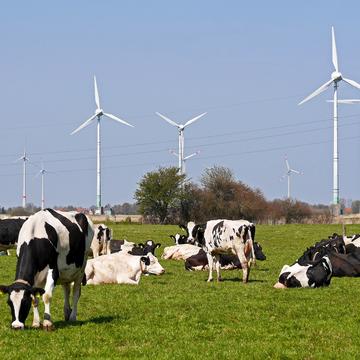Can we keep farming cows and sheep without dangerously warming the planet?
by Dr John Lynch, LEAP, University of Oxford

New ways of conceptualising and reporting methane could help reveal a potentially sustainable role for a certain level of ruminant livestock. But this doesn’t mean we can forget about the climate impacts of this methane, or ignore the other greenhouse gas emissions and wider environmental concerns related to ruminant production. A new piece from the Food Climate Research Network (FCRN) explores some of the arguments.
The last few years have seen a growing recognition that livestock farming makes a significant contribution to global warming. Cows, sheep and goats — ruminants — are particularly highlighted because they belch out methane, a powerful greenhouse gas, as a by-product of their digestion.
Methane is commonly reported and understood in terms of its ‘carbon dioxide equivalent’ impact, using a simplifying metric called the Global Warming Potential (GWP). The GWP describes each methane emission as being ‘equivalent’ to a certain amount of carbon dioxide (CO2) - or taken the other way round, that methane affects the climate as if it was a stronger version of CO2.
But the way in which these two gases contribute to global warming is a little more complicated. When we emit methane, most of it will naturally break down within decades, but for CO2 a portion of any emissions are expected to remain in the atmosphere for millennia. This marked difference in the lifetime of the gases means that the impacts of different emissions over time cannot be fully captured by imagining their impacts to be equivalent.
As I wrote in a previous blog piece, LEAP research has contributed to a new way of conceptualising different gases, suggesting that it may be helpful to treat short-lived gases such as methane separately to long-lived gases such as CO2. One of the most notable points highlighted by this new approach is that it would be possible to have stable temperatures without eliminating methane emissions – in contrast to the situation with CO2, where ‘net-zero’ emissions are required.
To briefly reiterate: because methane is short-lived, within a few decades ongoing emissions replace methane that has automatically been removed from the atmosphere, so if emission rates remain stable, they do not greatly add to further temperature increases, although they do maintain a higher temperature than it would be without this methane.
So where does this leave our cows, sheep and goats? In our FCRN piece “Methane and the sustainability of ruminant livestock”, we consider what this new way of thinking about methane might mean for food system sustainability.
This more nuanced way of comparing gases can suggest we might be able to retain a certain amount of ruminant livestock production in a way that is not possible for ongoing fossil fuel use. But while a stable cattle herd may not necessarily contribute a large amount of extra warming, their ongoing methane emissions will continue to contribute to elevated temperatures.
How much warming from ruminant methane might be compatible with our temperature targets depends on how quickly we can bring CO2 emissions down to net-zero. In theory, if we were able to eliminate CO2 imminently, we might even keep under 1.5 degrees even without major reductions to ruminant methane. In practice, CO2 emissions are extremely unlikely to fall fast enough to achieve this: they had not started declining at all, but look like they will drop in 2020 given the disruption wrought by Covid-19. Sticking to our 1.5-2 degree warming target will require action to limit emissions from all sectors. Current trends also show increasing ruminant methane emissions, which would add extra warming and make these temperature limits harder, or maybe even impossible, to stick to.
The climate impacts of ruminants are not limited to their methane emissions. Ruminant farms and their feed supply chains use energy and fertilisers, resulting in CO2 and N2O emissions, which, as long-lived gases, need to be minimised and offset to prevent extra warming.
Through their grazing or feed production, ruminants use a lot of land. If this land was recently converted from deforestation, for example, it will have resulted in additional CO2 emissions, but even if not, could represent a missed opportunity not to deploy this agricultural land for other purposes that might sequester more carbon. The exact balance of different emissions between alternative types of ruminant or other livestock production is a complex topic, and depends on the specifics between each system.
We must also keep in mind that the climate is only one part of the debate about ruminant sustainability. Agriculture, including many ruminant systems and their feed production, can contribute to other forms of pollution, decreasing air and water quality. The significant land-use footprint of ruminants has important implications for biodiversity: mirroring the arguments above, land conversion for agriculture is a major cause of biodiversity loss. Aflthough there are contexts where ruminant rearing and biodiversity objectives may be able to go hand in hand, in many cases biodiversity might be enhanced following the removal of ruminants from the land.
These issues must in turn be understood within an even broader context, bringing in conversations about, for example, the health impacts of different diets, animal welfare, and the social, economic or cultural roles of ruminants and ruminant farming.
The more nuanced take on methane compared to CO2 provided by recent research may, therefore, contribute to the debate about whether and what amount of ruminant production might be considered ‘sustainable’, but doesn’t mean that ruminant methane can now be forgotten about - and the climate impacts of methane are only one component of a bigger discussion. If what we eat and how we produce it continues along current trajectories, we look likely to go beyond what is sustainable for the climate and other environmental concerns.



